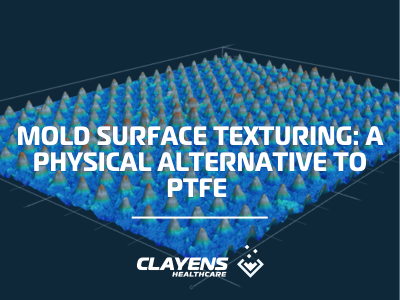Mold Surface Texturing: A Physical Alternative to PTFE

The progressive ban on PFAS is pushing manufacturers to seek reliable alternatives to the use of these persistent pollutants. As an innovative player in plastics processing for healthcare, Clayens is fully aligned with this dynamic by developing additive-free solutions that are high-performing, durable, and safe.
The surface functionalization technology developed by Clayens is based on the direct texturing of injection mold cavities, using patterns at the micro- and nanometric scale. These structures engraved in the tooling are then perfectly replicated on each injected plastic part, endowing the surfaces with new functional properties (hydrophobicity, anti-friction, antibacterial effect, etc.) without the need for chemical treatments or additives.
An Ecological and Economical Alternative
The aim of this new application is clear: to eliminate the use of fluorinated materials such as polytetrafluoroethylene (PTFE), or other lubricants commonly used to improve the sliding properties of technical plastics.
Not only do these substances pose environmental, regulatory, and health risks, but they are also costly. By replacing them with physical texturing integrated from the start of production, Clayens offers a cleaner, more durable, and more cost-effective solution, removing the added cost of additive materials.
Rigorous Hydrophobicity and Friction Tests
Trials were conducted on plates injected with textured molds, focusing on two types of testing: hydrophobicity and sliding performance.
For hydrophobicity, the contact angle of water droplets was measured on textured polyethylene (PE) surfaces, and compared to PTFE surfaces.
For sliding, tests measured the force required to initiate movement on a standard polyamide (PA) surface (natural, non-textured), compared with:
- a PA “PTFE-lubricated” surface (PA granules loaded with PTFE, commonly used in medical applications),
- and textured PA surfaces (50 different textures tested).
The test protocols were designed to ensure reproducibility in the laboratory, under strictly identical friction conditions.
Significant Results
[Insérer image à gauche du texte ci-dessous]
Légende : Photos of drop contact angles on textured and non-textured PE/PA plates
- Hydrophobicity: The textured surfaces achieved a contact angle of 142°, compared to average values between 110° and 126° for PTFE. This confirms the value of texturing in liquid repellency, without fluorine.
- Friction: 9 out of the 50 textures tested reduced friction force by at least 20% compared to PA/PTFE. Two textures even achieved nearly 40% reduction.
[Insérer image]
Légende : Improved sliding: comparison between 50 textured PA plates and PTFE-lubricated PA plates
An Economically Advantageous Approach
These results demonstrate that surface texturing can not only replace but even outperform fluorinated solutions with a 100% physical approach, free from migration, and fully suited to demanding environments such as medical and food applications.
Furthermore, since this solution can be replicated across large production series, Clayens notes that it enables substantial cost savings by eliminating the extra expense of PTFE-loaded materials. In some concrete cases, the cost of PTFE compounds can be up to three times higher than standard materials, making the advantage considerable for mass production.
Expanding Testing to New Functional Variables
“These results confirm the relevance of surface functionalization as a lever for sustainable innovation,” said Matthieu Besse, R&D Manager, Healthcare at Clayens. “Not only are we eliminating controversial additives like PTFE, but we are also achieving better performance with standard materials that comply with our clients’ regulatory requirements. These advances also pave the way for new texture/material combinations, including with other technical polymers used in gears, pistons, valves, and connectors.”
Clayens is actively exploring the opportunities offered by surface functionalization, with confirmed results in several major areas: hydrophobicity and flow, anti-friction, and bacterial adhesion reduction.
The next steps will focus on expanding trials to new materials.
About CLAYENS:
CLAYENS Healthcare, representing the healthcare activity of the CLAYENS Group, supports industrial health players (medical devices, pharmaceuticals, and diagnostics) in the development, industrialization, and manufacturing of custom medical devices and plastic components in compliance with international regulatory standards.
CLAYENS Healthcare offers a complete service, from R&D to production, including industrialization, qualification, validation, and regulatory support.
Present in 9 countries, the CLAYENS Group has nearly 5,000 employees and 32 manufacturing sites. The Group's 8 cleanrooms are located in France (ISO7), the USA (ISO8), and Mexico (ISO7)
More information : https://www.clayens.com/healthcare.
------
Contact us
+1 (347) 526-3019
